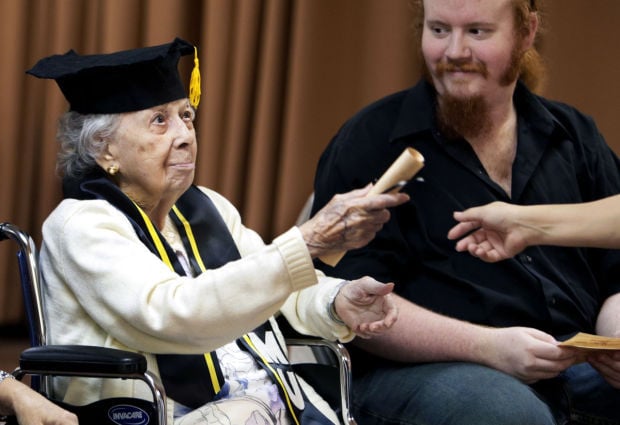Wearing a mortarboard, graduation stole, and surrounded by family, 104-year-old Mary Jo Stinnett earned a continuing education diploma last week.
“This is better than bingo!,” said Stinnett, who turns 105 on Thursday.
Stinnett was one of 24 residents who graduated from the “Villa Maria University” program at the central Tucson Villa Maria Care Center, which includes both nursing home and assisted living facilities. The graduates comprise about one quarter of the center’s overall population.
Rather than credit hours, officials at the center use the attributes of courage, curiosity and communication as measures of success. The program requires attendance and engagement in learning about new subjects like classical music and skills like yoga.
Stinnett, who was born before World War I in 1909, is Villa Maria’s eldest resident. While she has had some physical decline in recent years due to both general aging and a stroke six years ago, mentally she’s lively, lucid and wants to learn.
One of three “centenarians” — people over 100 years of age — at Villa Maria, Stinnett is among a small but significant group of Americans. While they comprise just .02 percent of U.S. residents, centenarians have been increasing in both numbers and proportion.
During the period between 1980 and 2010, the U.S. centenarian population grew by 66 percent — much higher than the overall population growth rate of 36 percent during that time, according to a U.S. Census report. About 53,364 Americans are older than 100, federal data show.
Studies on centenarian population growth have come to differing conclusions. One study out of England says more than one-third of babies born in 2012 in that country will live to celebrate their hundredth birthdays. Other studies say the growth in centenarians is slowing.
Tucson Medical Center has been hosting a party for Pima County centenarians for more than 20 years. While the size of the party in the last few years has remained a constant 40 to 50 centenarians, attendees at more recent parties have been an increasingly vital and engaged group, says L’Don Sawyer, manager for senior services at TMC.
Sawyer, who has attended for the past decade, has noted fewer wheelchairs and higher cognitive function than at past celebrations. Some still live on their own.
“The thing I see the most is resilience. These older adults have been through so many hard times, so many challenges,” Sawyer said. “They are all positive. They’ve experienced deaths of children, of spouses and of other loved ones. But they continue to get up and say, ‘today’s going to be a good day.’”
Stinnett was born in Cuba, grew up in Florida, and remembers meeting Fidel Castro. She likes to tell the story about how their politics clashed.
Until she moved to Villa Maria late last year, Stinnett had been living in Tucson with her daughter, Barbara Kaplan.
Kaplan attributes her mother’s longevity to healthy living — no smoking, not much alcohol, lots of vegetables and lots of walking. She has never driven, so walking has always been her go-to mode of transportation.
And other than a few frozen TV dinners during the 1950s, Stinnett stuck with cooking from scratch, which meant minimal processed food. She’s also got genetics on her side — other family members have lived into their 90s and beyond.
Stinnett’s daughter describes her as determined.
“She sees the glass half empty, but she’s going to fill it. She’s stubborn like that,” Kaplan said.





